When it comes to our children, we want to do what’s best for them and protect them from serious harm at all costs. That’s our job as parents, right?
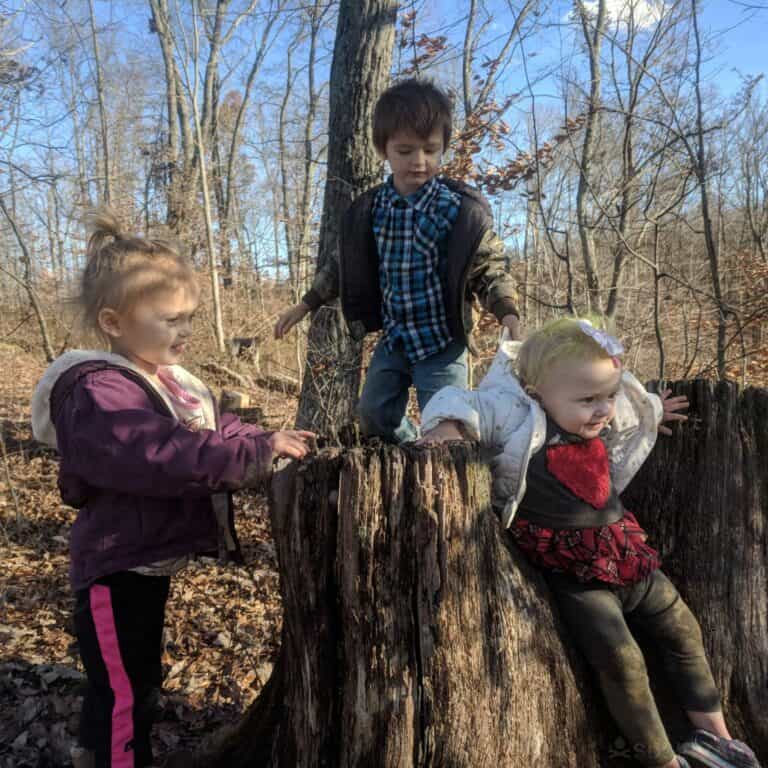
To safeguard our kids and teach them to become responsible, functioning adults. But with all that’s happening in the world today, it’s become even harder to make sure kids are safe. There are more dangers than ever looming over our heads. And as preppers, we are more aware than ever of those dangers.
Unfortunately, though we may joke about wanting to do it, we know we can’t wrap our kids in bubble wrap to keep them safe. Not only is it impossible but it’s not healthy.
They have to experience the world on their own in order to learn to become truly independent. And the reality is that as they get older we can’t always be there to protect them. So, the next best thing is to teach our kids how to protect themselves.
When it comes to how to explain emergencies, disasters, and prepping to kids, parents must walk a fine line. Tell your kids that sometimes bad things happen and although we can’t always stop bad things from happening, there are things we can do to protect ourselves and to get ready to react to those bad things when they happen.
If you explain too much to a child that isn’t ready, you can actually do more harm than good by creating extreme anxiety in your child. The goal isn’t to make your child afraid of the world.
But if you don’t explain anything, your child could be caught in a situation that they are ill prepared for and may cost them their life.
So how do you balance everything? How do you explain these things to your children so they can protect themselves without turning them into a basket case of nerves worrying about every little thing that could go wrong?
Table of Contents
Evaluate Your Own Behavior in a Crisis
Think about how you respond on a daily basis to things that go wrong:
- Are you terrified of spiders, snakes, dogs, loud noises, heights, etc.?
- Are you frightened by extreme weather like tornadoes, earthquakes, or hurricanes?
- Do you get angry and cuss or throw things when something breaks?
- Do you blame others when things go wrong or do you take responsibility and figure out how to set things right?
- Are you afraid of thunderstorms and lightning or do you sit in a chair on the porch and watch the awesome power of Mother Nature?
- Do you have a plan in place so that you can act quickly and with confidence when something happens or do you plan to call 911 and wait to be rescued?
- When a natural disaster or storm is predicted, do you run around in a panic trying to collect flashlights, batteries, cell phones, etc. or is everything organized and ready to go?
- When you or a loved one gets hurt, do you panic, cry, or rush to the emergency room or do you have a comprehensive first aid kit on hand that you can pull out to handle most types of injuries calmly and confidently?
- Do you follow basic safety rules when driving, walking at night, visiting an unfamiliar area, boating, etc.?
Reflect on your own childhood and the things that you were afraid of back then. Were any of those fears things that you know your parents were also afraid of? Were any of your fears based on a negative experience YOU had or were they based on the fact that you learned to be afraid because your parent or someone else was afraid?
Think about how you respond when something bad happens and make sure that the behavior your child sees from you is the way you’d want them to behave in a crisis. You’ll see why your own response to crisis is so crucial to explaining everything to kids in the next section.
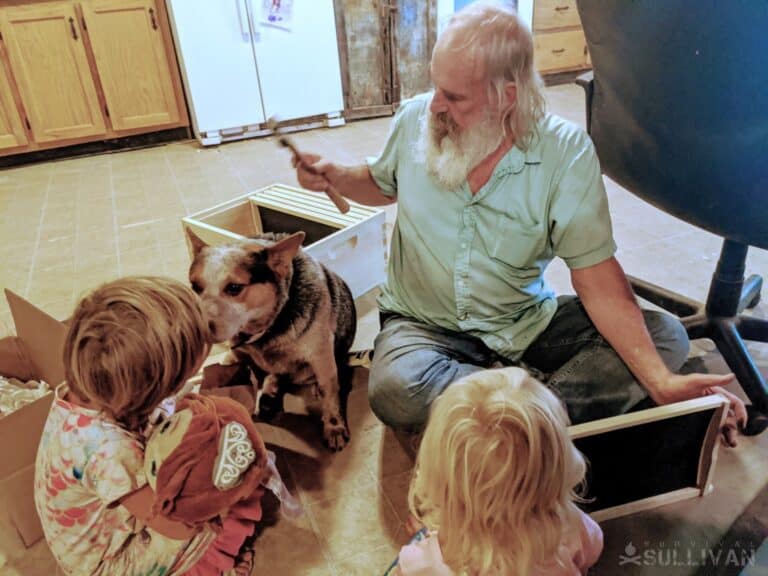
Be a Good Role Model for Preparedness Behavior
If you’ve ever experienced your toddler using your favorite cuss word in the correct context, you’ve seen behavior role modeling at its finest. Children mimic what they see and hear, especially when they are very young. Your child learned to eat, walk, and talk and yes even cuss by watching you and others they spend time with often.
My three-year-old grandson used the big MF word this summer and his mother was mortified but then she said “oh, that’s me all day long!”
She took steps to correct her use of foul language and it hasn’t been an issue with her son since. It’s quite the eye opener for parents to realize their child listens and copies everything they do, even when you think they aren’t paying attention to you.
When kids are very little, they are like knowledge sponges. They soak in everything they see, hear, touch, and feel. This is their main method of learning new skills. In fact, many experts believe that a child’s development from infancy to age five years old is the most crucial time of their life.
Their brains are developing in such a way that they are able to soak up almost unlimited knowledge. This could be the reason for the popular saying “Everything I need to know about life, I learned in kindergarten”.
You can teach kids about emergencies and being prepared at a very young age simply by modeling the preparedness behavior you want them to have.
The first step is to evaluate your own behavior. If your child sees you acting afraid of extreme weather events, they will likely mimic that fear. But if your child sees you acting calm as you prepare for expected bad weather, they will adopt your attitude about extreme weather.
When you’re getting ready to start the day, talk to your young child about how you make decisions. Talk about what the weather is like and how that helps to determine what kind of clothing you will wear for the day.
For example, saying something simple to your young child like:
“It’s hot out today, we’re going to wear shorts so we can stay cool but we’ll need to remember our sunscreen so we don’t get burned.”
Or
“The sky is getting dark and the weather man says there is a storm coming. Let’s bring all your toys and bike into the garage now just in case it gets windy.”
There are a thousand of these types of examples. If you consciously talk to your kids on a daily basis in this way, they will learn to pay attention to weather, to dress appropriately and prepare for what is likely to happen.
Having a routine at home and a designated place for things also makes it easier for kids to be prepared. If you have kids who are elementary age or older, have them lay out their clothes and everything they will need for school the night before.
In our house, the rule is you have to take a jacket even if you don’t want to wear it because it’s better to have it and not need it then need it and not have it. When you notice changes in the weather, point them out to your child so they can get in the habit of noticing these things too.
If kids ask questions about your EDC items, tell them honestly what you carry and how it can help in everyday emergencies or bigger situations. Let them begin to “copy” your EDC items first with pretend tools when they are very young. Gradually transition them to actual functioning items but make sure they are age appropriate and you give your child proper instruction and practice.
Disclosure: This post has links to 3rd party websites, so I may get a commission if you buy through those links. Survival Sullivan is a participant in the Amazon Services LLC Associates Program. As an Amazon Associate, I earn from qualifying purchases. See my full disclosure for more.
A flashlight or headlamp is a good item as long as the batteries are secure and can’t be swallowed accidentally. An emergency whistle, bandana, a paracord bracelet, etc. are all great items to start out with for kids.
As they get older, consider items such as the Dragonfly Wooden Knife by Spyderco or Kuhn Rikon Kinderkitchen Dog Knife with Teeth which comes with a great guide on how to handle and use it.
Knives aren’t allowed in school of course but your kids can put together their own EDC for school which could be made up of items they will need throughout the day such as tissues, extra pencils, extra lunch money, etc.
Know Your Child
One of the most important factors in how to explain emergencies, disasters, and prepping to kids is to know your child. Every child is different. Some kids can handle hearing about a tornado in a nearby town whereas other kids will become anxious or overly worried or afraid that it will happen to them.
Find out what your child already knows about a specific type of disaster, emergency, or prepping skill before you start giving them information.
Letting your child tell you what they already know about a topic gives you an idea of where to start with your explanation and if you need to correct any inaccurate information they may have heard from friends, school, or television, etc.
An understanding of the cognitive development of children can give you an idea of what they might be ready to handle at different ages.
Generally, babies up to about two years of age are in the Sensorimotor stage and they learn best by using their senses and touching and playing with objects. Memory and imagination develop in the Preoperational stage from about age two through age seven years.
Children begin to realize past and future and understand things symbolically. Starting at about five years old kids should develop better attention, increased memory and problem-solving skills. They are able to work towards goals and make connections between one or more ideas.
Kids from seven to eleven years of age are in the Concrete Operational Stage. This is where they will begin to notice events outside of themselves and start to recognize and feel compassion for the feelings of people other than themselves.
From age eleven on is the Formal Operational Stage. Children learn to use logic to accomplish things, solve problems, and plan for future events.
The above stages are guidelines and further research will give more insight into exactly which tasks fall under each category. But keep in mind that you know your child best. Try to stick to one or two new topics at a time until your child has mastered those. Make the topics something your child is interested in and something that is directly relevant for your area.
Provide Reassurance for Your Child
If you live in an area that frequently experiences disasters such as tornadoes, flooding, or hurricanes, etc. talk to your kids about how these things happen and what the family plan is for safety.
When explaining things to your child, emphasize ways to protect themselves. If you pay attention to your child, you’ll see clues that will indicate whether they are ready for more responsibility or if the information you’re providing is beginning to overwhelm them.
If you get a sense that your child is overly worried about their safety or the safety of others, reassure them that being prepared is a good way to help them stay safe.
Point out things that have been done to your home for example that make it stronger and able to better withstand a storm or other disaster or remind your child of the food, water, and other supplies you’ve stockpiled which will help you to hunker down and stay safe through a disaster, etc.
How to Emphasize Safety
Another way to explain prepping to kids is to simply emphasize safety. Prepping is really all about safety in the end. Most parents already teach safety on a regular basis without even realizing it.
Think about some of the safety actions you already teach your kids such as:
- Look both ways before crossing the street to avoid getting hit by a car
- Don’t talk to strangers without mom or dad present to avoid getting kidnapped
- Obey the traffic laws while driving, no texting or drinking while driving to avoid accidents
- Buckle their seat belt in order to be safer in the car
- Wear tennis shoes and a helmet when riding a bike
- To run away if a stranger approaches them on their way to or from school
- Wear a lifejacket during boating activities.
Here are some of the safety things I emphasize with my own kids and grandkids:
From the time they were little, I’ve pointed out different houses on our street that my kids can go to if they ever need any help from an adult when I’m not with them.
These are the families I’ve known myself for many years and I would point out the houses every time we drove by them on our way to or from somewhere else even before my kids were old enough to leave the yard alone.
If my kids are in trouble in our neighborhood when I’m not with them, I know they will react by running to the “safe” house that is nearest rather than to a stranger’s house.
When we go on an outing together as a family, whether it’s to a fair, festival, school football game, the zoo, or an amusement park, I remind my kids and grandkids before we go in that if they get separated from me they should go to the nearest person working there. I point out what the staff people are wearing (see those people with the bright orange shirts, logo, behind the counter, etc.).
If you are lost, go to the closest staff person, tell them your name and my name and that you are lost. As kids get old enough you can simply choose a meeting place you know they can find on their own such as the tallest ride or the information booth at the fair, etc.
If the worst happens and they are separated they make a beeline for that spot and wait because they know you will come there to get them. Even with the prevalence of cell phones, a meeting spot is a good idea in case your child’s cell phone dies or is broken and they can’t call you.
So emphasize the safety measures, and have a plan of action for events if:
- … they smell smoke in the house at night
- … they are home alone and someone knocks on the door or tries to get inside
- … the phone rings when they are home alone
- … they are chased by a dog
- … a car pulls up near the front yard and someone motions them to come closer
If you’ve taught your kids safety procedures for the above things, then it will seem perfectly logical to have safety plans for:
- Power outages
- Storms and other Natural Disasters
- Flooding in the house
- Downed power lines
- SHTF
Emergency Planning Begins with the Basics
All of this is great for giving kids a foundational understanding and appreciation for prepping, but how do we start putting it into practice?
As adults, we have the benefit of a lifetime of contextualization and further specialized knowledge in regards to survival and dealing with crises. Kids don’t, and though they are quick studies and quick to imitate mom and dad they won’t have any practice or experience under their belt until you get them started.
In my opinion, the best place to begin when it comes to getting your kids prepared to face all of life’s hazards, challenges and curveballs is with the absolute basics.
Kids, naturally, are less capable than adults pretty much across the board and it stands to reason that they will want to call for help if they are able.
One major shortcoming kids have to deal with today is an endemic problem brought about by our own prosperity and technology, namely the fact that all of our important phone numbers are remembered by our personal devices and the accounts that are attached to them. Deprived of these devices, most people don’t even know their own home phone number!
That is a great starting point. Have your children memorize their own phone number if they have a cell phone, your cell phone number, your home phone number if you have a landline and the phone numbers of other pertinent relatives, trusted family friends and potentially even workplaces.
Now, it is easy enough to memorize emergency phone numbers when diligently drilling the children on them, but long-term repetition entails recall. Don’t give them a gold star after they have memorized the requisite phone numbers until you can quiz them on it periodically and get perfect results every time.
This is imperative for getting children the capability to maintain communications with both yourself and other trusted members of the family in the event they are separated from their own phone or from your phone.
Phones are all around us out at pretty much every level of society, but they won’t do that much good for communicating if they cannot remember and recall the most essential phone numbers!
There is much more to do when it comes to drilling various survival skills and scenarios with your children, and we will break down the most important and basic ones below in the next section.
Practice Survival Scenarios with Your Kids
Your children won’t obtain the skills, confidence and experience to navigate emergencies and scary situations until you teach them. Luckily, the most common of these incidents are easy enough to deal with with just a little bit of practice and you have all the time in the world you need to practice them right now with your kids.
A few repetitions done periodically is better and more productive than one long, cram session that is likely to wear out a child and see them succumb to boredom.
We’ll talk a little bit more about staving off brain drain when practicing survival scenarios with your kids later, but for now read through the following and start implementing these drills with your children or your entire family as appropriate.
Lost or Missing Parent
This is the most poignant and also the most common emergency that a parent and a child go through. Everybody can relate to this, and I will guarantee you that almost all of us reading this experience this when we were children.
Remember the gut-wrenching fear, anxiety and sense of unreality you felt as a little child when suddenly mom or dad was just gone and you were out in public somewhere? It was not pleasant!
What’s worse, unattended children get into greater trouble. Sometimes they wander off and get genuinely lost. Other times they are snatched by opportunistic and monstrous child predators that move unseen and unknown through our society. Even at best, this is just a scary situation for parents and child alike!
The best thing you can do is talk to your child about it and go through steps that they can take to ensure that they will locate you and you can locate that. Or, barring that, get to someplace safe where you will surely be reunited.
Depending on the age of your child and where you usually go with them this could be something as simple as remaining calm and calling out for you or instructing them to move to a location in a store or other structure where they will be easily spotted.
Children instinctively want to hide when they get scared, and so it is far from unusual to find them hiding invisibly among clothing racks and department stores or cowering behind benches and other furniture elsewhere. This is understandable, but counterproductive, so teach them not to give in to it.
You can drill this when out in public by asking your child what they would do and where they would go at the moment if they looked up and mommy or daddy was just missing.
Walk through it with him and explain the thought process behind what and why they should take those actions. It won’t be long before your child will be adept at locating you or helping you locate them.
You should also teach them that they can trust uniformed first responders in the form of police officers, firemen and paramedics if mommy or daddy are not with them and they are scared.
Be sure to teach them that they need not be afraid of police officers or firemen who happened to be in full gear as they can appear quite intimidating to a smaller child.
Now, as always, keeping calm, cool and collected goes a long way towards achieving a good outcome. Instill this survival principle in your child early and often!
Dealing with Injuries
Injuries are a fact of life. Even the most agoraphobic, anxious and cautious person who never leaves their home will find injury and no short supply within the walls of their house.
Be it as a result of accident, mayhem or misadventure the bottom line is that people get hurt, kids and adults included. Teaching your child to properly deal with injuries should be among the very first things that they learn.
Now, I’m not some heartless monster and I do not mean to say that Mom or Dad shouldn’t run to the rescue and they get a skinned knee or take a tumble and get a bump on their head.
But smart parents have noticed that kids tend to react to anything less than grievous injury according to the reactions of their parents and people around them. If you freak out, they freak out generally speaking.
Accordingly, for minor injuries you should treat them like they are no big deal and an inconvenience to be dealt with.
Whatever you suffer a minor boo-boo, be it a burn, scrape, splinter or anything else make a learning opportunity of it by showing your child how you’ll deal with it and walking them through it as you take care of it. You can even do a little bit of role-play (and role reversal!) and have your child take care of an injury you receive.
Now, as children get older you should teach them that they might one day be the only person capable of helping not just themselves, but you.
Clever and prepared children have saved their parents lives in times of crisis when confronted with injury or other medical emergency. This might be from dialing 911 but it might be from direct intervention.
A friend of mine who is a full-time police officer and firearms trainer has taught both of his young daughters, aged 12 and 13, to deal with significant injuries through the use of tourniquets and other techniques, as well as to perform proper CPR.
He drills them on this periodically by announcing that he or mom are injured and then timing the girls on their retrieval of a medical kid and applying the proper intervention.
Depending on the intellect and capability of your child this can be as complex or as simple as circumstances demand, but getting your child tracking on the use of first aid and medical skills as early as possible will arm them against disaster for the rest of their life.
Family Fire Drills
One of the most important, if not the very most important, disaster training you can do with your child is the drilling of a family fire plan.
House fires are an entirely too common occurrence around the world, and in North America alone they cause hundreds of millions even billions of dollars in damage yearly and cost many hundreds of lives.
House fires can start through a variety of means, but it is usually the most mundane and innocent activities like cooking that start them.
However they start, house fires can go from small accidental fire to raging inferno in just a few minutes time, fully engulfing a house and everything and everyone in it. This means that you and everyone else in the house, but particularly children, must know what to do and take the appropriate action to respond to the situation at once.
Small children must be able to affect self-rescue, typically through leaving the house through the closest and best exit. This could be a window or a doorway.
Practicing this is simply a matter of announcing a fire drill, and then having the child move to and out of the exit and then heading towards a pre-arranged meeting point outside the home. As the child gains confidence and skill, start introducing modifiers to up the difficulty.
This could be a jammed or otherwise inoperable exit, or one blocked by fire that you imitate with props. You can even have the child wear goggles with smudged lenses or blindfold them to simulate the greatly reduced visibility that will occur thanks to the presence of smoke inside the structure.
This can make things pretty challenging and force them to feel their way out of the home.
Older and more capable children should be taught where the fire extinguishers are in the home, how to access them and how to use them properly to put out a fire before it gets too big.
This should be done with a live fire outside the home in controlled conditions, and sending capable children to a fire safety and remediation course is a great idea.
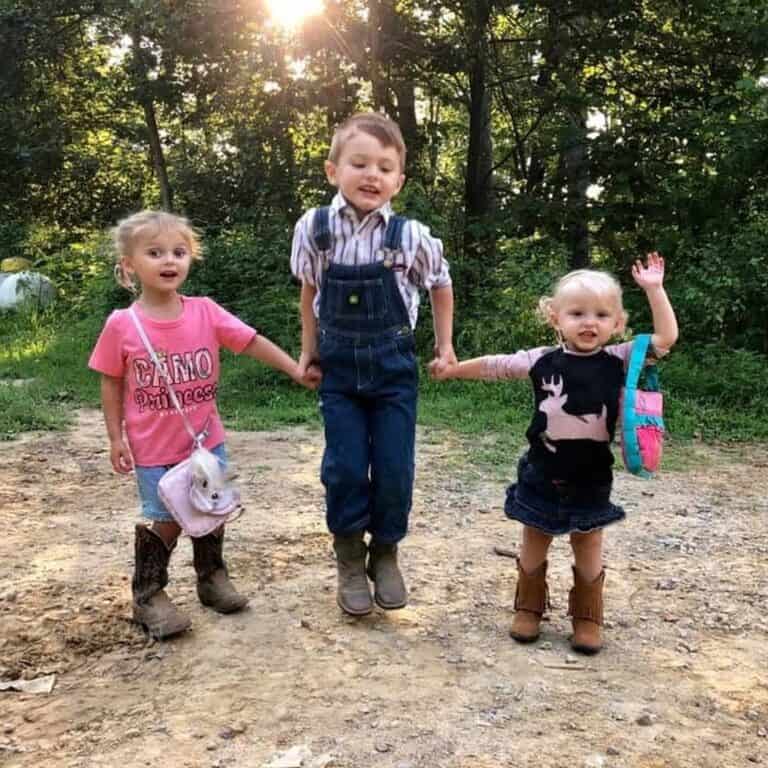
Keep Things Fun Until Your Child Matures
There is one more thing I would caution parents about in regards to training your child in the ways of the prepper.
Kids typically learn through play, or at the very least they learn better and swifter when they are enjoying themselves. Even when discussing a serious subject matter, even something that’s potentially dangerous or harmful, try to keep things light-hearted and fun particularly when dealing with younger children.
Trust me; you aren’t going to do them or you any favors by scaring them out of their wits. That’s just a great way to give them a complex early on. This is the typical pitfall of the overeager prepper parent and the sadistic coach alike. It is a poor tool, and a poor measure of a teacher.
But, context is everything. Inoculating people against stressful situations is valuable, and typically only done via adding stress until they can stay focused and work through it. So this is not to say that you should not add stressors to your child’s training in the form of time constraints or additional simulative elements.
However, I do recommend you save these stressors until the child is mature enough to handle them and act appropriately under the circumstances.
Younger children in particular have a hard time separating fantasy and fiction from reality and if your well intentioned training session or drill proves to be too intense or frightening they will likely shy away from it entirely.
Don’t forget to give your child praise when they do well or when they show significant improvement. Hardly anything beats the reinforcement of positive adulation!
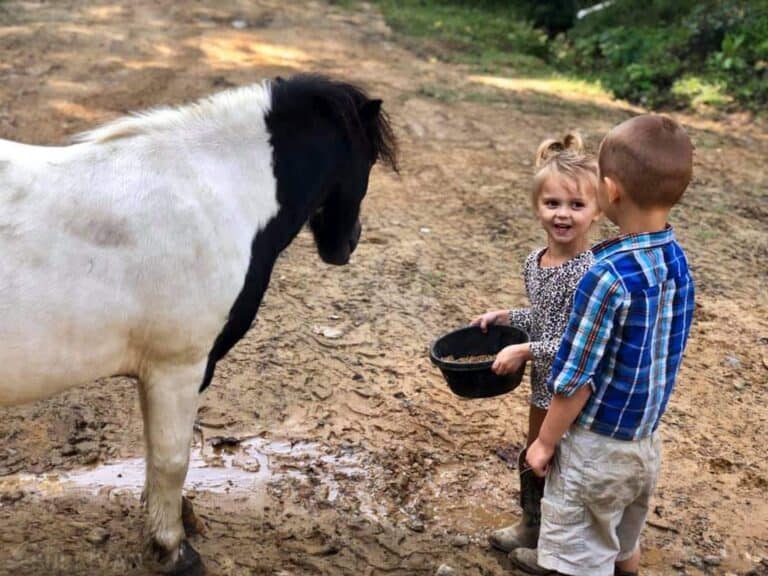
Let Them Help Out
Another way to explain emergencies, disasters, and prepping to kids is to let them help on a daily basis with routine preparations and home maintenance. If you’re baking bread or canning food, let your kids help with the tasks that are appropriate for their age.
As you work, explain what you are doing and why it’s important or how it helps keep things running smoothly or will protect you when bad things happen. Some of the preparations and home maintenance kids can help with include:
- Feeding and caring for livestock
- Gathering eggs from the chickens or helping to dispatch them for the freezer
- Cooking breakfast using different methods (campfire, propane stove, solar oven)
- Restocking the first aid kit for the house and car
- Inventory of food, water, and other supplies in your stockpile
- Checking to make sure doors and windows are locked at night
- Gathering firewood and building a fire when camping
- Putting up a tent in the backyard or while camping
- Topping off essential fluids in the car (gas, oil, power steering fluid, etc.)
- Filling water bricks or other containers to stockpile water
- Rotating food supplies in the pantry or other storage area
- Testing smoke detectors to make sure they are working
- Packing for a trip whether camping, vacation, or bug out
- Finding the way back from a hike or other “adventure” in the woods
- Plan your vacation route or the next trip to Disney
Talk to Your Kids Today
The bottom line is the best way to explain emergencies, disasters, and prepping to kids is to let your kids share in the experience as you are making preparations and plans for different events.
Give as much information as your child can handle for their age and maturity level, let them ask questions, and try not to overwhelm them with too much information at once.
If you emphasize safety, have patience, and make being prepared just another part of what they need to learn as they grow, your kids will learn the skills that are essential to keeping them safe. Kids are amazingly resourceful too, so you may just learn some new ways to do things too!
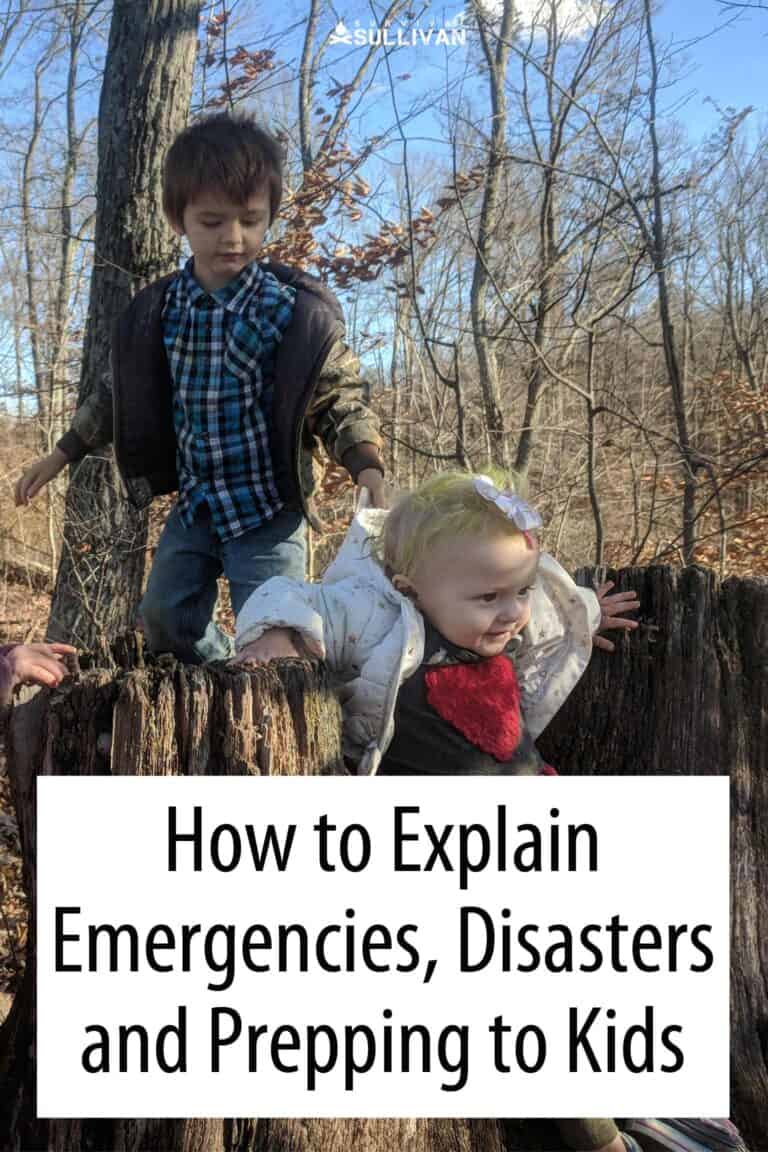
updated 02/17/2022

Born and raised in NE Ohio, with early memories that include grandpa teaching her to bait a hook and watching her mom, aunts, and grandmothers garden, sew, and can food, Megan is a true farm girl at heart.
For Megan, the 2003 blackout, the events of 911, and the increasing frequency of natural disasters like Hurricane Katrina, spurred a desire to be more prepared. Soon to be living off-grid, this mother of four and grandmother of ten is learning everything she can about preparedness, survival, and homesteading.

An excellent job of how to prepare children without frightening them.